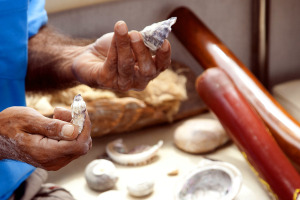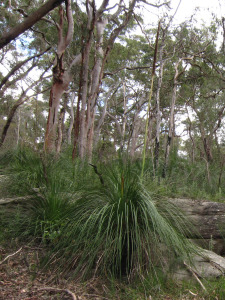

Shellfish was a common bush tucker in coastal regions. The remnants are found in middens, mounds of discarded shells and bones that are a type of Aboriginal Heritage Site. Photo: C.Munro for SydneyOutBack.com.au
After spending another day in Ku-ring-gai Chase National Park with the team of Sydney Out Back, I can’t help being inspired to learn bush survival skills from our knowledgeable Aboriginal guide, Les, and try more surprising examples of bush tucker that are hidden right in front of our eyes.
“We can eat fresh bush figs, right here at West Head…”, “We chewed that leaf…”, “Crush this in your fist and smell it”, “Bush tomatoes grow all around here, in season”, “That rare flower’s nectar is sweet like honey”, “Shellfish were a staple, the remnants of which are found in middens (a type of Aboriginal Heritage site in the park)”… bush tucker is seeded throughout this natural environment in Ku-ring-gai Chase National Park, where its Aboriginal custodians, the Guringai people, hunted, gathered and lived for generations. For the Aboriginal people – past and present – who “care for country”, the skill of living with the land (rather than just off it) was passed down through teaching and tradition, of which Sydney Out Back has become its latest student!
Learning about another culture is always eye opening; but learning about a living, yet ancient culture could be life changing. Sydney Out Back aims to respect our First Australians and be both a student and friend of their culture. There’s so much we are looking forward to learning from how the Aboriginal people respect and care for their natural environment, how they live in harmony with it, and the nutrition and medicines found in bush tucker all around us.
We are hopeful that every person journeying with Sydney Out Back on any Wilderness experience will come away richer for their encounter with both the inspiring natural environment of Ku-ring-gai Chase National Park and the ancient culture that has cared for Australia’s second oldest National Park (and surrounding region) for immeasurably longer than it’s been a National Park!
Visit this interesting summary of the top 10 Aboriginal Bush medicines according to Australian Geographic (http://www.australiangeographic.com.au/topics/history-culture/2011/02/top-10-aboriginal-bush-medicines/) and let us know if you’ve tried any of them. Did they help?

“Bush tucker is all around” you in Ku-ring-gai Chase National Park, although most of us wouldn’t even know where to look. Photo: K.Pickering, SydneyOutBack.com.au